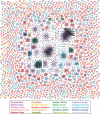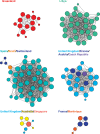The global transmission network of HIV-1
- PMID: 24151309
- PMCID: PMC3873788
- DOI: 10.1093/infdis/jit524
The global transmission network of HIV-1
Abstract
Human immunodeficiency virus type 1 (HIV-1) is pandemic, but its contemporary global transmission network has not been characterized. A better understanding of the properties and dynamics of this network is essential for surveillance, prevention, and eventual eradication of HIV. Here, we apply a simple and computationally efficient network-based approach to all publicly available HIV polymerase sequences in the global database, revealing a contemporary picture of the spread of HIV-1 within and between countries. This approach automatically recovered well-characterized transmission clusters and extended other clusters thought to be contained within a single country across international borders. In addition, previously undescribed transmission clusters were discovered. Together, these clusters represent all known modes of HIV transmission. The extent of international linkage revealed by our comprehensive approach demonstrates the need to consider the global diversity of HIV, even when describing local epidemics. Finally, the speed of this method allows for near-real-time surveillance of the pandemic's progression.
Keywords: human immunodeficiency virus; molecular epidemiology; transmission network.
Figures





Comment in
-
HIV-1 transmission networks in a small world.J Infect Dis. 2014 Jan 15;209(2):180-2. doi: 10.1093/infdis/jit525. Epub 2013 Oct 22. J Infect Dis. 2014. PMID: 24151310 Free PMC article. No abstract available.
References
-
- Tebit DM, Arts EJ. Tracking a century of global expansion and evolution of HIV to drive understanding and to combat disease. Lancet Infect Dis. 2011;11:45. - PubMed
-
- Hillis DM, Huelsenbeck JP. Support for dental HIV transmission. Nature. 1994;369:24. - PubMed
-
- Holmes EC, Brown AJ, Simmonds P. Sequence data as evidence. Nature. 1993;364:766. - PubMed
Publication types
MeSH terms
Grants and funding
- K24 AI100665/AI/NIAID NIH HHS/United States
- R01 AI047745/AI/NIAID NIH HHS/United States
- MH083552/MH/NIMH NIH HHS/United States
- R21 AI047745/AI/NIAID NIH HHS/United States
- GM093939/GM/NIGMS NIH HHS/United States
- AI74621/AI/NIAID NIH HHS/United States
- 095831/WT_/Wellcome Trust/United Kingdom
- U01 AI043638/AI/NIAID NIH HHS/United States
- R56 AI047745/AI/NIAID NIH HHS/United States
- DA034978/DA/NIDA NIH HHS/United States
- R01 MH083552/MH/NIMH NIH HHS/United States
- AI43638/AI/NIAID NIH HHS/United States
- AI47745/AI/NIAID NIH HHS/United States
- AI07384/AI/NIAID NIH HHS/United States
- AI36214/AI/NIAID NIH HHS/United States
- G0600587/MRC_/Medical Research Council/United Kingdom
- R01 GM093939/GM/NIGMS NIH HHS/United States
- K23 AI093163/AI/NIAID NIH HHS/United States
- T32 AI007384/AI/NIAID NIH HHS/United States
- DP1 DA034978/DA/NIDA NIH HHS/United States
- P30 AI036214/AI/NIAID NIH HHS/United States
- AI100665/AI/NIAID NIH HHS/United States
- P01 AI074621/AI/NIAID NIH HHS/United States
- AI093163/AI/NIAID NIH HHS/United States
LinkOut - more resources
Full Text Sources
Other Literature Sources
Medical

